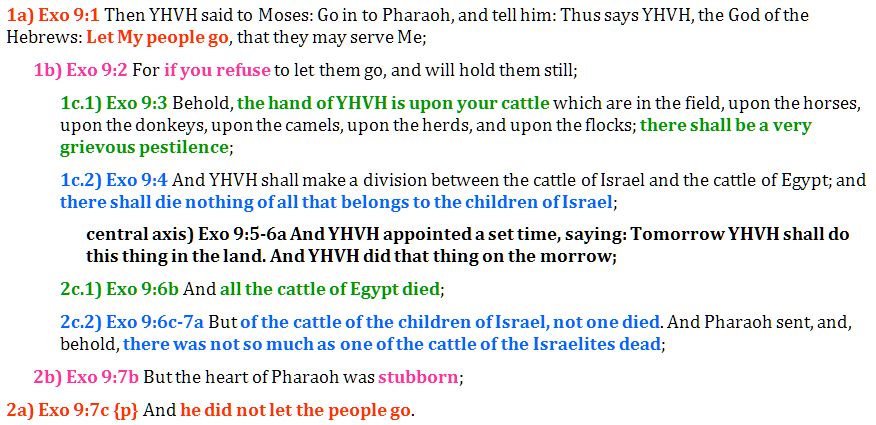Read Exodus 9:1-7 at Bible Gateway.
Hebrew paragraph division
Exo 9:1-7 {p} the plague of pestilence on the cattle
Original Hebrew
For refuse and stubborn, see Exo 7:8-25 strong theme.
Pestilence is Strong’s H1698, deber, a concrete noun meaning, “pestilence,” from Strong’s H1696 דבר dabar, a primitive root meaning, “to set in a row, to arrange in order, to speak.” The pictographs are dalet + bet + resh.
dalet ד = the door, thus enter, move, hang
bet ב = the house, thus house, household, family, in, within
resh ר = the head of man, thus head, first, top, beginning, man
The story the ancient pictographs are telling is of the back and forth movement (dalet) within the household (bet) of man (resh). In ancient days among the Semitic nomads, life followed an orderly arrangment of movement throughout the year, following the seasons in pasturing their flocks. This movement was repeated year and after year, thus the back and forth movement like the curtain in a doorway which moves back and forth as one enters and exits. However, a very specific order of movement was followed, thus the verb came to be widely used to mean “setting in order,” or “speaking,” as a verbal address follows from setting one’s words in order.
The positive spin on the verb is to arrange or order; the negative spin is to bring something outlaw into order by subduing through a pronouncement or judgment (a speaking). A related word is “bee,” because of the orderly arrangement of their hive; thus “swarm;” so we finally find the connection to the noun, as a pestilence breaks out on the body as a swarm.
Appointed is Strong’s H7760 שום suwm, a primitive root meaning, “to appoint.” Strong’s lists the characters as shin + vav + mem, but the Ancient Hebrew Lexicon lists the shin as originally a sin which was transposed over time.
sin ס = the thorn, thus grab, hate, protect
vav ו = the tent peg, thus add, secure, hook
mem מ, ם= the water, thus chaos, mighty, blood
The story the pictographs are telling is of protection (sin) secured (vav) against chaos (mem). Authorities appointed people over tasks, or times or places for the work or business of the tribe, so that anarchy did not reign.
A set time is Strong’s H4150, mo’ed, a concrete noun meaning, “set time;” from Strong’s H3259 יעד ya’ad, a primitive root meaning, “to point out, to define.” The ancient pictographs are yud + ayin + dalet.
yud י = the closed hand, thus work, throw, worship
ayin ע = the eye, thus watch, know, shade
dalet ד = the door, thus enter, move, hang
The story being told is the act (yud) which bears witness (ayin, as a witness testifies to that which he has seen) by entering in (dalet). When we gather at the appointed time and place to enter in to the tent of meeting (mo’ed) to worship, our lives bear a witness, which points out truth.
Exo 9:1-7 chiastic structure

This is the first plague where a loss of life occurs as a result of the plague; the loss of life is of the livestock. Incremental majesty accrues to YHVH, as He reveals to those who do not know Him that He does hold the power of life and death.

















LOVE THESE ROOT WORDS ALL THE MORE DAILY .. SPIRITUAL IMPACT CONTROLING ALL THINGS HAVING TO DO WITH LIFE AND NO LONGER BOUND BUT GIVEN ALL MY FATHER MADE MY INHERITACE AND JESUS NAME TAKES CARE OF SATAN …. YEA I KNOW WHO I AM … ITS ALL MERCY AND GRACE OVER ME … HUGS DEAR HEART ????